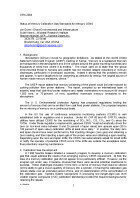Air Monitoring
Status of Mercury Calibration Gas Standards for Mercury CEMS
Oct 06 2014
Author: Jim Dunn, Scott Klamm, Stephen Mandel on behalf of CEM
1. Background
Atmospheric mercury knows no geographic limitations. As stated at the recent United Nations Environment Program (UNEP) meeting in Kenya, “mercury is a substance that can be transported in the atmosphere and in the oceans around the globe traveling hundreds and thousands of miles from where it is emitted.” The report went on to state that “the global environmental threat to humans and wildlife has not receded despite reductions in mercury discharges, particularly in developed countries. Indeed it shows that the problems remain and appear, in some situations to be worsening as demand for energy, the largest source of human made mercury emissions, climbs.”1
The UNEP report states that mercury poisoning of the planet could be best reduced by curbing pollution from power stations. The report, compiled by an international team of experts, says that coal-fired power stations and waste incinerators now account for around 1,500 tons, or 70 percent, of new, quantified manmade mercury emissions to the atmosphere.
The U. S. Environmental protection Agency has proposed regulations limiting the amount of mercury that can be emitted from coal fired power stations. The proposal requires the monitoring of mercury on a continuous basis
In the US the use of continuous emissions monitoring systems (CEMS) is well established both in regulation and in practice. Under 40 CFR 60 and 40 CFR 75, electric utilities have utilized CEMS for the monitoring of SO2, NOx, CO, CO2, and O2 since the 1970s. Under these regulatory requirements, gaseous CEMS “must automatically check the zero (or low level value between 0 and 20 percent of span value) and upscale span (50 to 100 percent of span value) calibration drifts at least once daily.” In practice, the daily zero and span checks have been performed by first injecting nitrogen (zero gas) and obtaining a zero reading, and then injecting a span gas of the proper value and obtaining a span reading. Depending upon the zero and span drifts, the CEMS can automatically adjust for small drifts or notify the operator of potential CEMS errors if the drifts are outside the acceptable band, thus potentially requiring maintenance.
Digital Edition
AET 28.2 April/May 2024
May 2024
Business News - Teledyne Marine expands with the acquisition of Valeport - Signal partners with gas analysis experts in Korea Air Monitoring - Continuous Fine Particulate Emission Monitor...
View all digital editions
Events
Jul 30 2024 Jakarta, Indonesia
China Energy Summit & Exhibition
Jul 31 2024 Beijing, China
2024 Beijing International Coal & Mining Exhibition
Aug 07 2024 Beijing, China
IWA World Water Congress & Exhibition
Aug 11 2024 Toronto, Canada
Aug 25 2024 Stockholm, Sweden and online






.jpg)








